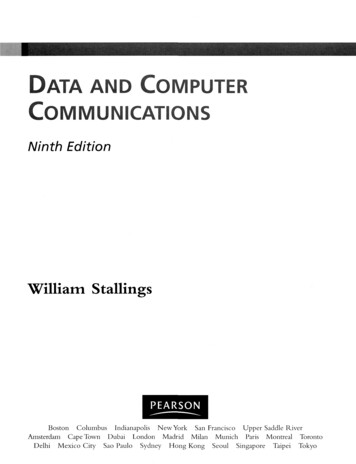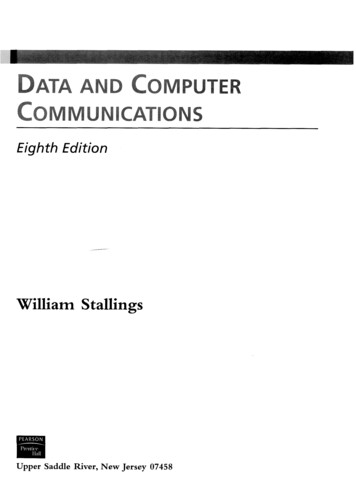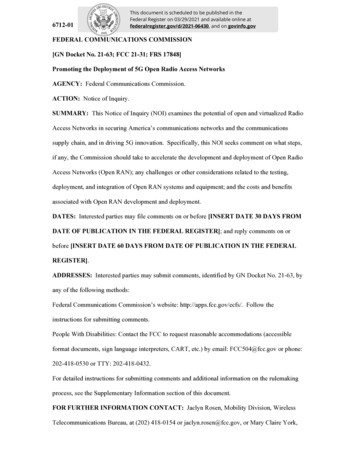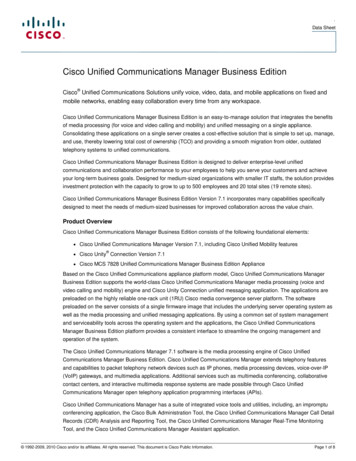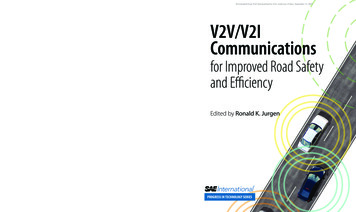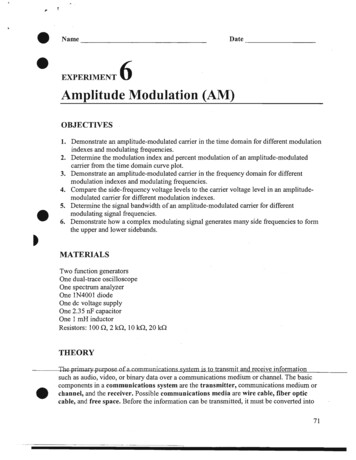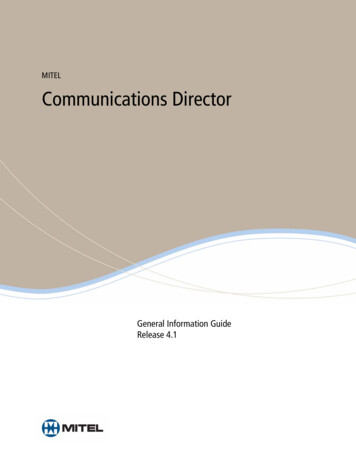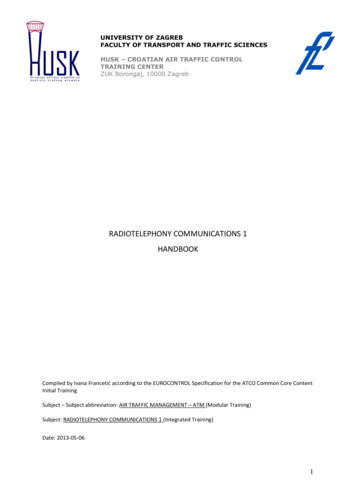
Transcription
UNIVERSITY OF ZAGREBFACULTY OF TRANSPORT AND TRAFFIC SCIENCESHUSK – CROATIAN AIR TRAFFIC CONTROLTRAINING CENTERZUK Borongaj, 10000 ZagrebRADIOTELEPHONY COMMUNICATIONS 1HANDBOOKCompiled by Ivana Francetić according to the EUROCONTROL Specification for the ATCO Common Core ContentInitial TrainingSubject – Subject abbreviation: AIR TRAFFIC MANAGEMENT – ATM (Modular Training)Subject: RADIOTELEPHONY COMMUNICATIONS 1 (Integrated Training)Date: 2013-05-061
1 CONTENTS123456789CONTENTS . 2RTF GENERAL OPERATING PROCEDURES . 42.1TRANSMITTING TECHNIQUE . 42.2TRANSMISSION OF LETTERS . 42.3TRANSMISSION OF NUMBERS . 62.4EXCEPTIONS TO NUMBERS . 72.5TRANSMISSION OF TIME . 82.6CALL SIGNS . 82.6.1 AERONAUTICAL STATIONS . 82.6.2 CALL SIGNS – AIRCRAFT . 92.7CATEGORIES OF MESSAGES AND ORDER OF PRIORITY . 10ESTABLISHMENT AND CONTINUATION OF COMMUNICATION . 123.1INITIAL CALL . 123.2MULTIPLE CALL . 123.3GENERAL CALL . 133.4ACKNOWLEDGEMENT OF MESSAGE RECEIPT . 13STANDARD WORDS AND PHRASES . 14READ BACK REQUIREMENTS . 17TEST PROCEDURES - RADIO CHECK AND READABILITY SCALE . 19Q CODES . 21METEOROLOGICAL INFORMATION . 228.1WAKE VORTEX SEPARATION . 238.2BRAKING ACTION . 238.3ESSENTIAL INFORAMTION ON AERODROME CONDITIONS . 248.4AMOUNT OF WATER ON THE RUNWAY . 248.5SKY COVERING IN OKTAS . 248.6WEATHER INFORMATION . 258.7AUTOMATIC TERMINAL INFORMATION SERVICE (ATIS) . 258.8VOICE WEATHER BROADCAST (VOLMET) . 26ORDER OF INSTRUCTIONS IN AERODROME CONTROL ENVIRONMENT . 279.1DEPARTURE INFORMATION . 289.2ENGINE STARTING PROCEDURES . 309.3PUSH-BACK/POWER-BACK PROCEDURES . 329.4ATC CLEARANCE . 349.4.1 IFR . 349.4.2 VFR . 359.5TAXI PROCEDURES . 399.6LINE UP . 429.7CONDITIONAL LINE-UP CLEARANCE . 449.8TAKE OFF CLEARANCE. 449.8.1 CANCELLATION OF TAKE-OFF CLEARANCE AT THE HOLDINGPOINT 479.8.2 REJECTING THE TAKE OFF CLEARANCE DURING THE TAKE OFFRUN 479.9REPORTING AIRBORNE . 479.10GO AROUND . 499.11LOW APPROACH . 502
9.129.139.149.159.169.179.18LOW PASS . 50TOUCH AND GO . 51FULL STOP LANDING . 52FLYING IN THE TRAFFIC CIRCUIT/PATTERN/ZONE . 52DELAYING ACTIONS . 57AERODROME CONTROL - TRAFFIC INFORMATION . 58JOINING INSTRUCTIONS, FINAL APPROACH AND LANDING . 593
2 RTF GENERAL OPERATING PROCEDURESPilots and air traffic controllers communicate by using the radiotelephony phraseology that consists ofa set of standardized words and phrases approved for the radiotelephony communications by ICAO in allroutine aircraft situations. The communication is made possible due to their common and work-related topics,especially because the situations they find themselves in are highly predictable. Even if misunderstandings dooccur, they are rather easily dealt with since both parties engaged in the conversation know what replies toexpect from each other. Problems arise in non-routine and emergency situations, when pilots and controllershave to resort to plain English because the phraseology lacks the communicative means for effectivecommunication in unpredictable situations such as on board medical emergencies, engine problems, fuelshortage or terrorism. When both parties stick to the rules prescribed, problems in communication will rarelyoccur. First of all, good transmitting technique is needed.2.1 TRANSMITTING TECHNIQUEAccording to the ICAO Doc 9432 Manual of Radiotelephony the following transmitting techniques will assist inensuring that transmitted speech is clearly and satisfactorily received:1. Before transmitting, listen out on the frequency to be used to ensure that there will be no interferencewith a transmission from another station.2. Be familiar with good microphone operating techniques.3. Use a normal conversational tone, speak clearly and distinctly.4. Maintain an even rate of speech not exceeding 100 words per minute. When it is known that elementsof the message will be written down by recipient, speak at a slightly slower rate.5. Maintain the speaking volume at a constant level.6. A slight pause before and after numbers will assist in making them easier to understand.7. Avoid using hesitation sounds such as "er".8. Depress the transmit switch fully before speaking and do not release it until the message is completed.This will ensure that the entire message is transmitted.9. An irritating and potentially dangerous situation in radiotelephony is a "stuck" microphone button.Operators should always ensure that the button is released after a transmission and the microphoneplaced in an appropriate place that will ensure that it will not inadvertently be switched on.2.2 TRANSMISSION OF LETTERSThe phonetic words shall be used when individual letters are required to be transmitted.4
Some abbreviations have become unmistakable through common usage and are transmitted without using thephonetic word for each letter e.g. ILS, QNH, QFE.The following words are to be used when it is required to transmit individual letters.Table 1: THE RADIOTELEPHONY SPELLING ALPHABET (ICAO, Annex 10, Chapter 5)LetterWordPronunciationMorse codeAAlphaAL FAH.BBravoBRAH VOH.CCharlieCHAR LEE or SHAR LEE. .DDeltaDELL TAH.EEchoECK OH.FFoxtrotFOKS TROT. .GGolfGOLF.HHotelHOH TELL.IIndiaIN DEE AH.JJulietJEW LEE ETT.KKiloKEY LOH.LLimaLEE MAH. .MMikeMIKENNovemberNO VEM BER.OOscarOSS CARPPapaPAH PAH. .QQuebecKEH BECK.RRomeoROW ME OH. .SSierraSEE AIR RAH.TTangoTANG GOUUniformYOU NEE FORM or OONEE FORM.VVictorVIK TAH.WWhiskeyWISS KEY.XX -rayECKS RAY.YYankeeYANG KEY.ZZuluZOO LOO.The underlined syllables are to be emphasised when being pronounced.5
2.3 TRANSMISSION OF NUMBERSAll numbers except whole hundreds, whole thousands and combinations of thousands and whole hundredsshall be transmitted by pronouncing each digit separately.Whole hundreds and whole thousands shall be transmitted by pronouncing each digit in the number ofhundreds or thousands followed by the word HUNDRED or TOUSAND as appropriate. Combinations ofthousands and whole hundreds shall be transmitted by pronouncing each digit in the number of thousandfollowed by the word TOUSAND and the number of hundreds followed by the word HUNDRED.The following examples illustrate the application of this procedure:Table 2: Pronunciation of numbersTable 3: Examples of pronunciation of numbersNumeralPronounced as:NumberPronounced as:0ZERO10WUN ZE-RO1WUN75SEV-en FIFE2TOO100WUN HUN-dred3TREE583FIFE AIT TREE4FOWER2500TOO TOU-SAND FIFE HUN-dred5FIFE5000FIFE TOU-SAND6SIX11000WUN WUN TOU-SAND7SEVEN18900WUN AIT TOU-SAND NIN-er HUN-dred8AIT25000TOO FIFE TOU-SAND9NINER38143TREE AIT WUN FOW-er TREEHundredHUN DREDThousandTOU SANDDecimalDAY SEE MALPointPOINTNumbers containing a decimal point shall be transmitted with the decimal point in appropriate sequence beingindicated by the word DECIMAL (in case of frequencies) or POINT (in all other cases).a)indicated by the word DECIMALe.g. 124,725 - one two fower decimal seven two fiveb) pronounced point in all situations except for frequenciese.g. distance 11.5 miles - distance one one point fife milesTable 4: Reporting Mach numberCTN123, report Mach numberCTN123, 0.75 (point seven fife)CTN123, reduce to 0.72 (point seven two).6
When the frequency of an aeronautical station is an intermediate 25 kHz the full figure will comprise 6 digits:124,725 - ONE TWO FOWER DECIMAL SEVEN TWO FIFETable 5: Pronunciation of numbers containing decimal pointNumberTransmitted as:0,72 MachMACH POINT SEVEN TWO1,2 MachMACH ONE POINT TWO25,5 NMTWO FIFE POINT FIFE MILES120.375ONE TWO ZERO DECIMAL THREE SEVEN FIVE118.000ONE ONE EIGHT DECIMAL ZERO118.005ONE ONE EIGHT DECIMAL ZERO ZERO FIVE118.050ONE ONE EIGHT DECIMAL ZERO FIVE ZERO118.125ONE ONE EIGHT DECIMAL ONE TWO FIVE118.150ONE ONE EIGHT DECIMAL ONE FIVE ZERO118,300ONE ONE EIGHT DECIMAL TREE2.4 EXCEPTIONS TO NUMBERSExcepted from these above mentioned regulations are:1. azimuth in terms of 12 o clock in passing traffic information in radar environment shall be transmitted as"ten", "eleven" or "twelve" o clock (e.g. “CTN 662, traffic information, traffic is at 12 o'clock, 6 miles,passing left to right, B737, FL 350”)2. course, heading, track, radial, flight level, speed (e.g. heading 300 – “tree zero zero”)3. QNH (1000)4. squawk (7500)5. instruction to fly a 360 turn, (e.g. "Make a tree sixty turn to the left.")6. instruction to make a U-turn on ground, (e.g. "Make one eighty turn".)7. visibility over 10 (ten) km.VERIFICATION OF NUMBERSWhen necessary to verify the accurate reception of numbers, the person transmitting the message shallrequest the person receiving the message to read back the numbers.7
2.5 TRANSMISSION OF TIMEAll time references should be made in Co-ordinated universal time (UTC). This used to be called GreenwichMean Time (GMT). This time zone is sometimes referred to as Zulu (Z). Time is always in the 24 hour clock.2400 is midnight and 0001 begins the new day.When transmitting time, only the minutes of the hour are normally required, each figure being pronouncedseparately.However, if there is any possibility of confusion or if crossing the hour, the full four-figure group will be spoken.Correct time, expected approach time (EAT and revised EAT) and SLOT time are to be spoken in hours andminutes (in four figures). EAT and SLOT are to be read back always.Apart from UTC (Co-ordinated universal time), estimated times of arrival may sometimes be given as local time.Table 6: Transmission of timeTimeStatement0920TWO ZERO orZERO NINER TWO ZEROEAT 1015EAT ONE ZERO ONE FIFECORRECT TIME 2010CORRECT TIME TWO ZERO ONE ZERO1300WUN TREE ZE-RO ZE-RO2057TOO ZE-RO FIFE SEV-enPilot may check the time with the appropriate ATS unit. Time check shall be given to the nearest half minute.Table 7: Time checkCTN 654, REQUEST TIME CHECKCTN 654, TIME 0611CTN 654, TIME 0715 AND A HALF2.6 CALL SIGNSICAO, Annex 10, Chapter 5 distinguishes two types of call signs. Call signs can be considered as names used inaviation to indentify aircraft stations and aeronautical stations which are in fact stations on the ground.2.6.1 AERONAUTICAL STATIONSAeronautical stations are identified by the name of the location followed by a suffix denoting unit or the type ofservice provided.8
Table 8: Aeronautical station call signsUnit or serviceCall sign suffixArea control centreCONTROLRadar (in general)RADARApproach controlAPPROACHApproach control radar arrivalsARRIVALApproach control radar departuresDEPARTUREAerodrome controlTOWERSurface movement controlGROUNDClearance deliveryDELIVERYPrecision approach radarPRECISIONDirection finding stationHOMERFlight information serviceINFORMATIONApron controlAPRONCompany dispatchDISPATCHAeronautical stationRADIOWhen satisfactory communication has been established, and provided that it will not be confusing, the name ofthe location or the call sign suffix may be omitted.2.6.2 CALL SIGNS – AIRCRAFTAn aircraft call sign shall be one of the following types:a)the characters corresponding to the registration marking of the aircraft; G-ABCD or Cessna G-ABCD.(The name of the aircraft manufacturer or name of aircraft model may be used as a radiotelephonyprefix);b) the telephony designator of the aircraft operating agency, followed by the last four characters of theregistration marking of the aircraft; Speedbird DCAB;c)the telephony designator of the aircraft operating agency, followed by the flight identification. CTN662.Full radiotelephony call signs shall always be used when establishing communication (initial call).After satisfactory communication has been established, and provided that no confusion is likely to occur,aircraft call sign may be abbreviated as follows:a)the first and at least the last two characters G-CD or of the aircraft registration; Cessna G-CD;b) the telephony designator of the aircraft operating agency followed by at least the last two charactersof the aircraft registration; Speedbird AB;9
c)No abbreviated form; CTN 662.Table 9: Aircraft call signsTYPEFULL CALL SIGNABBREVIATED CALL SIGNTYPE ACESSNA FABCDCESSNA CDN 57826N26TYPE BVARIG PVMAVARIG MATYPE CSCANDINAVIAN 937SCANDINAVIAN 937An aircraft shall not change its type of call sign or alter its call sign during flight except when there is alikelihood that confusion may occur because of similar call sign. Then, an aircraft may be instructed by an airtraffic control unit to change the type of its call sign temporarily:a)instruction to change its type of call sign:CHANGE YOUR CALL SIGN TO (new call sign) UNTIL FURTHER ADVISED ;b) instruction to an aircraft to revert to the call sign indicated in the flight plan:REVERT TO FLIGHT PLAN CALL SIGN (call sign) AT (significant point) .An aircraft shall use its abbreviated call sign only after it has been addressed in this manner by theaeronautical station.Aircraft in the heavy wake turbulence category shall include the word "HEAVY" immediately after theaircraft call sign in the initial contact between such aircraft and ATS units.2.7 CATEGORIES OF MESSAGES AND ORDER OF PRIORITYAccording to ICAO, Annex 10, Chapter 5 all the communication between pilots and air traffic controllers can becategorised into 6 categories of messages depending on the priority of information being transmitted. Croatianthregulations (AIC A03/08) distinguishes the 7 type, called state telegram:1.DISTRESS CALLS, DISTRESS MESSAGES, AND DISTRESS TRAFFIC (poruka nevolje) - A condition of beingthreatened by serious and /or imminent danger and of requiring immediate assistance (MAYDAY –radiotelephony signal)2.URGENCY MESSAGES, including messages preceded by the medical transports signal – (porukahitnosti) - A condition concerning the safety of an aircraft but does not require immediate assistance(PAN,PAN or PAN, PAN MEDICAL – radiotelephony signal)10
-Medical transport – “any means of transportation by land, water, or air, whether military orcivilian, permanent or temporary, assigned exclusively to medical transportation and under thecontrol of a competent authority of a Party to the conflict”3.DIRECTION FINDING MESSAGE/COMMUNICATION RELATING TO DIRECTION FINDING (porukeradiogoniometrijskog smjera) - VDF using Q codes, radar vectors4.FLIGHT SAFETY MESSAGES (poruke o sigurnosti leta)- movement and control messages- messages originated by an aircraft operating agency or by an aircraft, of immediate concern to anaircraft in flight;- meteorological advice of immediate concern to an aircraft in flight or about to depart (individuallycommunicated or for broadcast);- other messages concerning aircraft in flight or about to depart.5.METEOROLOGICAL MESSAGES (meteorološka poruka) - reports, forecasts, warnings); comprisemeteorological information to or from aircraft.6.FLIGHT REGULARITY MESSAGES (letačko operativna poruka)- messages regarding the operation or maintenance of facilities essential for the safety or regularity ofaircraft operation;- messages concerning the servicing of aircraft;- instructions to aircraft operating agency representatives concerning changes in requirements forpassengers and crew caused by unavoidable deviations from normal operating schedules.- messages concerning non routine landings to be made by the aircraft;- messages concerning aircraft parts or materials urgently required;- messages concerning changes in aircraft operating schedules.7.STATE TELEGRAM – (državni telegram – in Croatia)11
3 ESTABLISHMENT AND CONTINUATION OFCOMMUNICATIONIn radiotelephony communications it is considered that the communication has been established after thestation being called has answered the call being made by the station calling. After the initial call only theaircraft call sign shall be used and the aeronautical station call sign is omitted since there can be many aircraftunder jurisdiction of the same aeronautical station and communicating with it during a certain time.3.1 INITIAL CALLInitial call is the call usually initiated by the pilot and it consists of the pilot’s message and the controller’s reply.When establishing RT communications, if the pilot initiates it, s/he shall use the full call sign of aeronauticalstation and the full aircraft call sign. The contact is established when the called station replies using full call signof the station calling and the station being called. Each message shall include:1.A CALL (THE STATION CALLED AND THE STATION CALLING)2.A CONTENTTable 10: Initial callATCPILOTZAGREB TOWER, 9ADDC, request start up9ADDC, ZAGREB TOWER, start up approved.PULA TOWER, ------ 345STATION CALLING PULA TOWER, SAY AGAIN YOURCALL SIGN.PULA TOWER, CTN 345All stations, CTN 622 request assistance for Split,relay the message (no call sign was heard).Station calling Zagreb Tower, say again the call signAfter the initial call, only the aircraft call sign is to be used. When a station is called, but it is not certain whatthe identification of the station calling is, the calling station should be requested to repeat its call sign untilidentification is established.3.2 MULTIPLE CALLStations in the aeronautical mobile service may simultaneously call several stations. Stations called in multiplecall shall acknowledge receipt of the message in the sequence used by the calling station.12
3.3 GENERAL CALLWhen an aeronautical station broadcasts information to all stations on the same frequency, the messageshould be prefaced by “all stations” and end with the word “OUT”. Aircraft (pilot) shall not attempt toacknowledge the receipt of the general call message.Table 11: General callALL STATIONS, ZAGREB TOWER, ANTI-HAIL ACTIVITYSOUTH OF THE AERODROME COMPLEDTED. OUT.3.4 ACKNOWLEDGEMENT OF MESSAGE RECEIPTAcknowledgement of the receipt of aircraft/aeronautical station message is made by transmission of theaircraft call sign and the word ROGER may be added.13
4 STANDARD WORDS AND PHRASESAccording to ICAO, Annex 10, Chapter 5 the following phrases and their meanings are to be used in standardcommunication between the pilots and air traffic controllers. Phrases written in Italics are still to be found inCroatian regulations (AIC A03/08) but have been excluded from the ICAO documents.Table 12: Standard words and phrasesACKNOWLEDGELet me know that you received and understood this message.ADVISE (HR)Tell us/Inform us on/of/about.AFFIRMYes.AIRBORNE (HR)The time the flight has started after the take-off phase.APPROVEDPermission for proposed action granted.BREAKI hereby indicate the separation between portions of the message. (To be used where there isno clear distinction between the text and other portions of the message.)BREAK BREAKI hereby indicate the separation between messages transmitted to different addressees in avery busy environment.CANCELAnnul the previously transmitted clearance.CAUTION (HR)Beware of the following conditions or situations.CHECKExamine a system or procedure. (No answer is normally expected.)CLEAREDAuthorized to proceed under the conditions specified.CLIMB (HR)Climb to maintain (to level out).COMPLY (HR)Act in compliance with a request or instruction.CONFIRMI request verification of: (clearance, instruction, action, information).CONTACTEstablish communications with .CORRECTTrue or accurate.CORRECTIONAn error has been made in this transmission (or message indicated). The correct version is.CROSS (HR)Fly/taxi across. Pass from one side to the other side of.DEPART (HR)Leave.DEPARTURE (HR)Take-off, departing.DESCEND (HR)Descend to maintain (to level out).DISREGARDIgnore.ESTIMATE (HR)Calculate/make approximate calculation.EXPEDITE (HR)Speed up, increase speed/rate.HOLD (HR)Keep in place or condition.HOLD SHORT (HR)Keep at a distance/keep away of/ stop before reaching the specified location HOW DO YOU READWhat is the readability of my transmission?IMMEDIATEL(LY) (HR)At once, without delay due immanent risk/hazard14
I SAY AGAINI repeat for clarity or emphasis.LEAVE (HR)Depart, abandon, go away from.LOOK OUT (FOR) (HR)View over, survey inspection (watch out for immanent risk/hazard.)MAINTAINContinue in accordance with the condition(s) specified or in its literal sense, e.g. Maintain VFR.MONITORListen out on (frequency).NEGATIVENo/Permission not granted/That is not correct/Not capable.OUTThis exchange of transmission is ended and no response is expected. (Not normally used in VHFcommunications)OVERMy transmission is ended and I expect a response from you. (Not normally used in VHFcommunications)READ (HR)Hear and understandREAD BACKRepeat all, or the specified part of this message back to me exactly as received.RECLEAREDA change has been made to your last clearance and this new clearance supersedes yourprevious clearance or part thereof.REPORTPass me the following information.REQUESTI should like to know/I wish to obtain.REVISION (HR)Reconsidered or corrected version/calculation of time.ROGERI have received all of your last transmission.SAY AGAINRepeat all, or the following part of your last transmission.SLOW DOWN (HR)Reduce your speedSPEAK SLOWERReduce your rate of speech.SQUAWK (HR)Set the mode/code as instructed.STANDBYWait and I will call you.UNABLEI cannot comply with your request, instruction or clearance. (normally followed by a reason)VERIFY (HR)Check and confirm with originator.WILCOI understand your message and will comply with it.WORDS TWICEa) As a request: Communication is difficult. Please send every word, or group of words, twice.b) As information: Since communication is difficult, every word, or group of words, in thismessage will be sent twice.Manual or Radiotelephony distinguishes ATC clearance from ATC instruction.Air traffic control clearance (ODOBRENJE) is an authorization for an aircraft to proceed under conditionsspecified by an air traffic control unit. (For convenience, the term “air traffic control clearance” is frequentlyabbreviated to “clearance” when used in appropriate contexts. The abbreviated term “clearance” may beprefixed by the words “taxi”, “take-off”, “departure”, “en-route”, “approach” or “landing” to indicate theparticular portion of flight to which the air traffic control clearance relates).15
Air traffic control instruction. (UPUTA) Directives issued by air traffic control for the purpose of requiring apilot to take a specific action.16
5 READ BACK REQUIREMENTSImportant instructions issued by the ATCO need to be repeated by the pilots so that it is made certain that thepilot has heard the message correctly. The ATCO will acknowledge the correct read-back by transmitting theaircraft call sign and the phrase “CORRECT”.The following instructions are to be read back, i.e. are to be transmitted by verbatim repetition using the samewords and the same sequence and are to be concluded with the aircraft call sign.1.LEVEL INSTRUCTIONSC: CTN 320, descend to 3000ft.C: CTN 320, after passing ZAG descend to FL 210.2.SPEED INSTRUCTIONSC: CTN 663, maintain present speed.C: CTN 663, increase speed to 220 kt.3.HEADING INSTRUCTIONSC: 9A DDA, turn right heading 150.C: CTN 663, fly present heading.4.SSR OPERATING INSTRUCTIONSC: 9A CBE, squawk 6502.C: CTN 320, confirm squawk 5505.5.ATS ROUTE CLEARANCESC: CTN 663, cleared to Zagreb via flight planned route, FL 190, CRE 2D, squawk 7065.C: AUA 644, Zagreb Radar, identified, cleared to PIS, descend to 9 000 ft, QNH 1010, TL 95, expect ILSapproach RWY 05.6.ALTIMETER SETTINGSC: 9A BPW, QNH 1003.7.8.VDF INFORMATIONC: 9ADDA, transmit for DF.P: 9ADDA, transmitting for DF 1,2,3,4,5.C: 9ADDA, fly QDM 045.P: Flying QDM 045, 9ADDA.FREQUENCY CHANGESC: 9A DDA, contact Zagreb Tower 118,3.C: 9ADDA, monitor 135,8.9.APPROACH CLEARANCES (EAT - ESPECTED APPROACH TIME inclusive)C: CTN 505, EAT 101010. ATIS CODE LETTER AND DATAC: 9ADDA, check information C.11. TAXI INSTRUCTIONSC: 9AHGD taxi to holding point RWY 23, wind 220/16.17
12. TRANSITION LEVELC: CTN 663, descend to 6000 ft, QNH 1013, transition level 7013. POSITION UPON THE TERMINATION OF RADAR VECTORING OR RADAR SERVICEC: CTN 642, radar service terminated, position 25 NM to CRE, on track 192 degrees, resume ownnavigation to Pula.14. SLOT TIMEC: CTN 622, slot time 0805.15. CONDITIONAL CLEARNACESC: CTN 663, after passing KOPRY, climb to FL 290.16. RUNWAY DESIGNATOR AND CLEARANCES TO:a)ENTERC: CTN 662, cleared to enter RWY 31.b) LAND ONC: CTN 662, cleared to land RWY 05, wind 050 degrees, 4 kn.c)TAKE OFFC: CTN 662, cleared for take off, wind 230 degrees, 5 kn.d) REJECT TAKE OFFC: CTN 662, stop immediately, CTN 662, stop immediately, aircraft crossing the RWY.C: CTN 662, hold position, cancel, I say again, cancel take off clearance, vehicle on the RWY.e)CROSSC: CTN 662, cleared to cross RWY 05.f)BACKTRACKC: CTN 662, cleared to backtrack RWY 09.g)LINE UPC: CTN 662, line up RWY 05.h) HOLD SHORT OF AN ACTIVE RUNWAYC: CTN 662, hold short of RWY 05.(INCLUDING THE CONDITION OF A CODITIONAL CLEARANCE)18
6 TEST PROCEDURES - RADIO CHECK ANDREADABILITY SCALEWhen radio checks are made, the following readability scale is to be used to indicate the quality of thetransmission:Table 13: Readability scaleQualityScaleUnreadable1Readable now and then2Readable but with difficulty3Readable4Perfectly readable5Test transmissions should consist of the following items:1.the identification of the aeronautical station being called2.the aircraft identification3.the words "RADIO CHECK"4.the frequency being usedReplies to test transmissions should be as follows:1.the identification of the station calling2.the identification of the station replying3.information regarding the readability of transmissionTable 14: Radio check procedure9A DAS, Zagreb Tower, reading you fiveZagreb Tower, 9A DAS, radio check 118,3 (box 1)9A HBD, Zagreb Tower, reading you three, with a loudbackground whistle.9A HBD, Zagreb Tower, you are unreadableNOTE. - The readability of a transmission should be classified by the number (Table 13), together with anyother information regarding the transmission which may be useful to the station making the test.19
Exercise 1: Work in pairs. Produce examples of radio check using the following prompts:ZAGREB TOWERSPLIT TOWERDUBROVNIK TOWERCTN 692CTN 622MAH 492118.275124.725120.005ZAGREB TOWERZAGREB TOWERZAGREB TOWERDLH 392CTN 125THY 226119.005123.250118.350PULA TOWERZAGREB TOWERZAGREB TOWERBAW 407SAS 257JAL 658117.255121.010119.500ZAGREB TOWERZAGREB TOWERZAGREB TOWEROAL523MYT 546TSO 453121.225118.025119.15020
7 Q CODESThe Q code is a standardized collection of three-letter message encodings, all starting with the letter "Q",initially developed for commercial radiotelegraph communication, and later adopted
Pilot may check the time with the appropriate ATS unit. Time check shall be given to the nearest half minute. Table 7: Time check CTN 654, REQUEST TIME CHECK CTN 654, TIME 0611 CTN 654, TIME 0715 AND A HALF 2.6 CALL SIGNS ICAO, Annex 10, Chapter 5 distinguishes two types of call signs. Call signs can be considered as names used in



